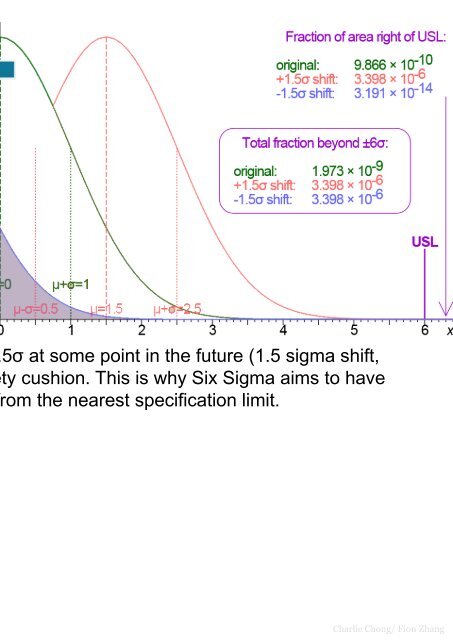Understanding ASQ-CQA -Knowing The Ways
You also want an ePaper? Increase the reach of your titles
YUMPU automatically turns print PDFs into web optimized ePapers that Google loves.
Role of the 1.5 sigma shift<br />
Experience has shown that processes usually do not perform as well in the long term as they do in the short term. As a result, the<br />
number of sigmas that will fit between the process mean and the nearest specification limit may well drop over time, compared to<br />
an initial short-term study. To account for this real-life increase in process variation over time, an empirically based 1.5 sigma shift<br />
is introduced into the calculation. According to this idea, a process that fits 6 sigma between the process mean and the nearest<br />
specification limit in a short-term study will in the long term fit only 4.5 sigma – either because:<br />
• the process mean will move over time, or<br />
• because the long-term standard deviation of the process will be greater than that observed in the short term,<br />
• or both.<br />
Hence the widely accepted definition of a six sigma process is a process that<br />
produces 3.4 defective parts per million opportunities (DPMO). This is based on the<br />
fact that a process that is normally distributed will have 3.4 parts per million outside<br />
the limits, when the limits are six sigma from the "original" mean of zero and the<br />
process mean is then shifted by 1.5 sigma (and therefore, the six sigma limits are no<br />
longer symmetrical about the mean).<br />
3 sigma process<br />
<strong>The</strong> former six sigma distribution, when under the effect of the 1.5 sigma shift, is<br />
commonly referred to as a 4.5 sigma process. <strong>The</strong> failure rate of a six sigma<br />
distribution with the mean shifted 1.5 sigma is not equivalent to the failure rate of a<br />
4.5 sigma process with the mean centered on zero. This allows for the fact that<br />
special causes may result in a deterioration in process performance over time and is<br />
designed to prevent underestimation of the defect levels likely to be encountered in<br />
real-life operation.<br />
0<br />
<strong>The</strong> role of the sigma shift is mainly academic. <strong>The</strong> purpose of six sigma is to<br />
generate organizational performance improvement. It is up to the organization to<br />
determine, based on customer expectations, what the appropriate sigma level of a<br />
process is. <strong>The</strong> purpose of the sigma value is as a comparative figure to determine<br />
whether a process is improving, deteriorating, stagnant or non-competitive with others<br />
in the same business. Six sigma (3.4 DPMO) is not the goal of all processes.<br />
http://onlinestatbook.com/2/calculators/normal_dist.html<br />
https://en.wikipedia.org/wiki/Six_Sigma<br />
Charlie Chong/ Fion Zhang

















